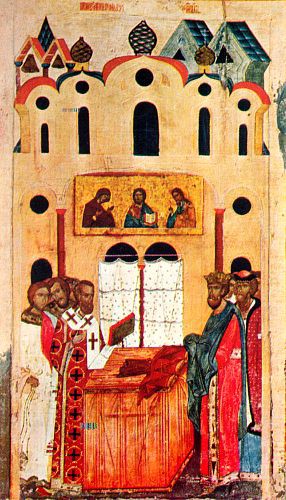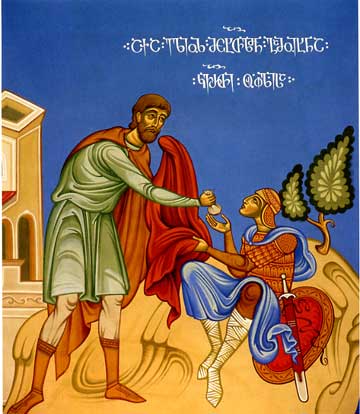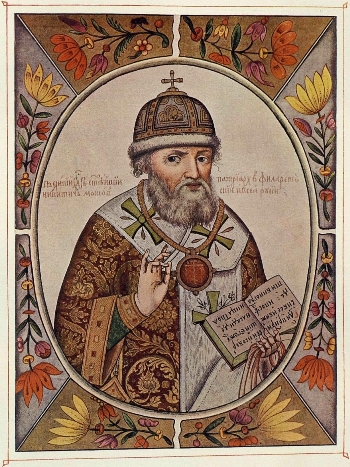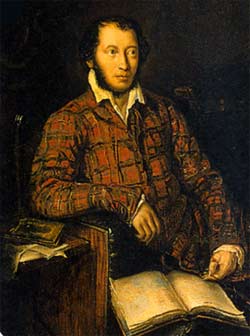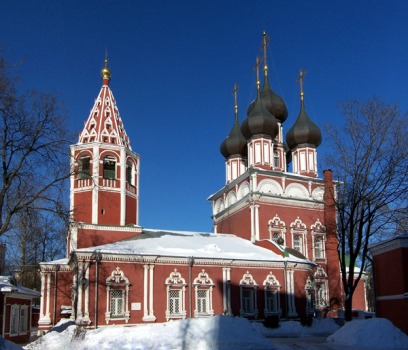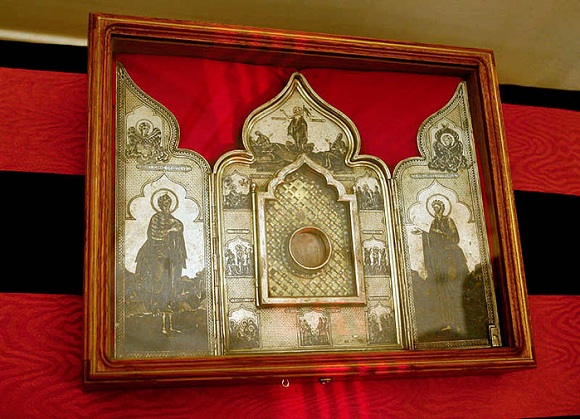On July 23 [N.S.] the Russian Orthodox Church celebrates the Deposition of the Precious Robe of our Lord Jesus Christ in Moscow, in memory of the acquisition of this sacred object in 1625. Before coming to Russia, this honored relic changed hands more than once. According to the Gospel account, one of the soldiers acquired His chiton [inner tunic] – the Lord’s Robe – by lot: They said therefore among themselves, Let us not rend it, but cast lots for it, whose it shall be: that the scripture might be fulfilled, which saith, They parted My raiment among them, and for my vesture they did cast lots (John 19:24).
The long road to Moscow
The circumstances of the translation of the Lord’s Robe from Jerusalem are described in various Eastern accounts from Armenia, Georgia, and Syria.
According to tradition, the soldier who acquired the Lord’s Robe was Georgian and subsequently brought it back to his country. According to another account, a community of Jewish immigrants had settled in Iberia (Georgia) during the Babylonian captivity; their descendents lived in Mtskheta, the ancient capital of Iberia. The Jews of Mtskheta sent envoys to Jerusalem each year to participate in the celebration of Passover. One of them, named Elioz, witnessed the suffering of Jesus Christ on Golgotha and came to believe in Him. He was able to acquire the Lord’s Robe from the soldier who had won it by lot; he then returned with it to Mtskheta. The Lord’s chiton remained in Georgia until the beginning of the seventeenth century.
The subsequent fate of the Lord’s Robe is closely bound up with the history of the relations of three states: Georgia, Persia, and Russia. When the Persian Shah Abbas I conquered Georgia in 1616-1617, Tsar Mikhail Fydorovich of Russia took King Teimuraz of Georgia under his protection by the latter’s request. In 1622, during negotiations on the future of Georgia and King Teimuraz, the Shah informed the Russian envoy that he was in possession of the Lord’s Chiton, which he claimed to have seized in Georgia, and that he intended to send it to Moscow, to Tsar Mikhail Fyodorovich and Patriarch Philaret Nikitich.
Several accounts exist in ancient Russian literature about how the Lord’s Robe came to be in Moscow. One of these belongs to Prince Semen Shakhovskoy, a well-known writer of the seventeenth century (this account is included in the manuscript collection compiled by the academician N. S. Tikhonravov). Authentic documents testifying to the delivery of the Lord’s Robe to Moscow were preserved in the main archive of the Ministry of Foreign Affairs in Moscow and were published in 1879; later “The Matter of the Lord’s Robe Sent to Moscow by Shah Abbas,” which had belonged to the same archive, was also published. S. Belokurov’s 1891 study, “The Matter of the Lord’s Robe Sent to Moscow by Shah Abbas to Tsar Mikhail Fyodorovich in 1625,” cites texts from embassy documents, including facsimile from this correspondence.
It should be noted that a tradition exists in the West that the Lord’s Robe was first found by the Empress Helen (IV c.) in Palestine and then brought to Trier in 328, where it was placed in the Trier Cathedral. This “alternative” tradition emerged in Western Europe in 1196; popular veneration of the Trier relic began there in 1512.
Shah Abbas was true to his word: in March 1625 the Persian ambassador Urusambek brought the Precious Robe to Moscow as a gift from Shah Abbas to His Holiness, Patriarch Philaret. The relic was placed in a gold reliquary [lit., “ark”] decorated with precious stones. The Patriarch was also presented with a letter in which the Shah stated that, having conquered Georgia, he found this sacred object concealed in a cross in the Metropolitan’s sacristy.
That same day, Patriarch Philaret examined the reliquary with the entire sacred council: “Upon inspection of the ark, a piece of cloth [was found], close to red in color, resembling linen, or changed in appearance from its long years, woven, and [measuring] one span in width and length.”
Inasmuch as the king who had sent the Robe was of another faith, and “words of non-believers cannot be accepted as evidence without verification,” evidence of the authenticity of the relic began to be sought. The bishops and archimandrites from Greece and Jerusalem who were in Moscow at the time unanimously affirmed that their Churches preserved the tradition that the Savior’s Robe was located in Georgia, to which it had been brought by a soldier who had been present at the crucifixion of Jesus Christ.
Patriarch Philaret, however, wished to have confirmation from above. The following was decreed on March 22, 1625: “All monasteries should observe a seven-day fast and the Lord God should be beseeched in all churches that He Himself might reveal His will concerning this sacred object; and the sacred object itself is to be borne in procession through the city with the chanting of molebens and is to be placed upon the ill.”
Many of the ill received healing after the Lord’s Robe had been placed on them. Fourteen cases of miraculous healings from the Lord’s Robe were reported during the week of the Veneration of the Cross (the fourth week of Great Lent). This served as indisputable evidence of the authenticity of the Lord’s Robe. The solemn deposition of the Precious Robe in the Dormition Cathedral of the Moscow Kremlin took place on March 27. Soon a copper “tent” shrine was constructed in the southwest corner of the cathedral, in the side chapel of Sts. Peter and Paul.
Although the Lord’s Robe had been brought to Moscow in March, because this occurred during Great Lent the feast of the Deposition of the Precious Robe in Moscow was established on July 10 (old calendar), on the eve of the anniversary of the enthronement of Tsar Mikhail Fyodorovich. With the blessing of His Holiness, Patriarch Philaret, a service was compiled by Metropolitan Cyprian of Krutitsa (Sarai and Don). On its feast day the Lord’s Robe was brought out to the middle of the church for veneration by the faithful.
Not subject to the passage of time
According to the 1627 inventory of the Dormition Cathedral, the church had three fragments of the Lord’s Robe: “On the Lord’s Tomb is a gilded silver ark; on the ark is a carved image of the Crucifixion of our Lord Jesus Christ; in the same ark is another smaller gilded silver ark, within which is the Robe of our Lord Jesus Christ… A silver kiot, which contains a fragment of the Lord’s Robe lies on the Lord’s Tomb… A smaller gilded silver kiot, which contains a fragment of the Lord’s Robe under the seal of the great sovereign, His Holiness, Patriarch Philaret Nikitich of Moscow and All Russia. On the ark is an image of the Lord’s Crucifixion, along the edges is a single strand of pearls, and at its head is an image of the Savior…”
From other parts of the inventory it follows that one portion of the Robe was called the “greater”; the second was the “lesser”; and the third was designated for being to taken to the homes of the ill. Moreover, fragments of the Robe were distributed to monasteries. Thus, in 1626 Patriarch Philaret gave a small fragment thereof to the Ipatiev Monastery near Kostroma.
Around 1627 the icon “The Deposition of Christ’s Robe” was painted. On the feast day of the Deposition of the Lord’s Robe, the Nail of the Lord was also venerated. The latter had been brought to Moscow by King Archil Vahtangovich of Georgia, who had settled in Moscow; later Peter I decreed that the Nail should be handed over to the Dormition Cathedral for safekeeping.
Orthodox Christians came in great numbers to the Dormition Cathedral to venerate the Savior’s Robe. Those afflicted by grave illnesses, and therefore unable to travel to the cathedral, asked to have the Lord’s Robe brought to them in their homes for healing. This happened so often that the Robe was divided into several portions. Moreover, believers who received the Lord’s Robe into their homes detached small particles from it. They did so out of the pious desire to have a relic in their homes, but they thereby unwittingly inflicted harm upon it.
Therefore His Holiness, Patriarch Joachim, was compelled to issue a special decree in 1681: “Henceforth this most precious treasure is not to be divided.” Following the Patriarch’s decree, two reliquaries were prepared for preserving the Lord’s Robe. The first contained a fragment of the Robe along with a fragment of the Life-Giving Cross of Christ. Once a year, on Great Friday, it was brought out in church. During the reign of Paul I (1796-1801), the Emperor ordered that this reliquary with the Robe be brought to St. Petersburg, to the Great Church of the Winter Palace. Another portion of the Robe was kept in the Sts. Peter and Paul Cathedral, in the “fortress.”
The second reliquary with a portion of the Robe remained as before in the Dormition Cathedral in the Kremlin. This is how the fragment in Moscow looked: “The fragment of the Savior’s Robe located in the Dormition Cathedral is slightly more than a square vershok [1.75 in.]; it is placed in a gold reliquary that is, in turn, placed in a silver folding kiot (6.5 x 4 vershoks) [11 x 7 in.], covered with blackened sacred images and decorated in the middle under glass with 180 large diamonds, one of which weighs 7.5 karats.” The portion remaining in Moscow continued to be brought out annually for veneration.
In 1701, Peter I went to war against Sweden; Russia was fighting for an outlet to the Baltic Sea. Grave trials were in store, so the Tsar ordered a stone Church of the Deposition of the Robe to be constructed in Moscow on the place where the Savior’s Robe had been met when it was first brought to Russia by the Persian embassy. Nonetheless, the Robe continued to be preserved in the Dormition Cathedral. Judging by the inventories, five reliquaries with a total of eight portions of the Lord’s Robe were kept therein. Two portions were sent to Petersburg and one to Yaroslavl.
Over the course of the centuries the relics preserved in the Kremlin’s Dormition Cathedral were guarded from the gaze of foreigners: they could contemplate them only from afar.
There was no access to the Lord’s Robe during the “invasion of the Gauls,” when Moscow was occupied by Napoleonic troops. It, along with other sacred objects, was removed ahead of time from Moscow to Vologda. Following the defeat of Napoleon, the Patriarchal vestry was returned from Vologda to Moscow and the Lord’s Robe resumed its former place in the Dormition Cathedral.
In 1837, A. N. Muravyev, who then served in the post of “Secretary to the office of the Ober-Procurator” in the Holy Synod, was in the suite of the Grand Duke Alexander Nikolayevich (the future Emperor Alexander II) when the latter was accompanying Metropolitan Philaret (Drozdov) of Moscow on an inspection of the churches in the Moscow Kremlin. He also visited the vestry of the Dormition Cathedral that had been rescued during the Patriotic War of 1812. Recalling this visit, Muravyev made the following remark: “His Highness recalled that at the Baptism of every child of the Imperial Family a fragment of the Lord’s Robe is placed in his cross; thus does the patriarchal blessing extend to all his offspring.”
This remark is confirmed by information contained in the vestry inventory of the church in the Winter Palace in Petersburg. It mentions the following: “An image of the Mother of God of Tikhvin in a gold riza with a small cross in which are preserved fragments of the Robes of the Savior and the Mother of God. On the back of the image is this inscription: ‘Her Imperial Majesty Maria Feodorovna blesses His Imperial Majesty Alexander Pavlovich with this image on the day of his Baptism, December 20, 1777. A cross is also entrusted to him.’” It follows that the Lord’s Robe was in the care of the Royal Family and that the leaders of All Russia could dispose of it at their pleasure.
An inventory of the church in the Winter Palace in St. Petersburg confirms that a reliquary with a portion of the Lord’s Robe was “received into the vestry from the rooms of His Imperial Majesty Paul I.” The list contains a detailed description of the revered object: “A gold ark, arranged like a book, containing a portion of the Robe or Chiton of our Lord Jesus Christ stitched onto a silk pillow. The arc is decorated with enamel images of the four Evangelists and the Lord’s suffering, as well as with diamonds, sapphires, and emeralds.” There is brief mention of the other silver reliquary that also preserved a portion of the Robe: “A silver ark, gilt, with fragments of the Wood of the Lord’s Cross, the Lord’s Robe, and the relics of various saints.” This first portion of the Robe was reverently preserved in the palace church until the beginning of the twentieth century.
The other portion of the Lord’s Robe was kept in the Cathedral of Sts. Peter and Paul (“the fortress”) until 1917. It is possible that the “Peter and Paul” portion of the Robe had been brought to the northern capital by order of Paul I, as was the “palace” portion, but no reliable data exists on this point.
Fragments of the Lord’s Robe were kept not only in Orthodox churches, but also by certain noble families. Here is what Alexandra Petrovna Arapova, daughter of Natalia Nikolaevna Pushkina-Lanskaya, writes: “The family of the Pushkin boyars has from time immemorial preserved a metal amulet with a fairly crude engraving of the All-Seeing Eye on it that contains securely within it a fragment of the Lord’s Robe. It is the obligatory possession of the eldest son, who is charged with the duty of having a moleben served before it on July 10, the feast day of the Deposition of the Robe. Pushkin carried this out his entire life and instructed his wife to observe the same and, when the time came, to bequeath it to her eldest son, making him promise never to shirk from this family vow.”
“The Bolsheviks held sway ruthlessly”
After 1917, the Petersburg reliquary with a fragment of the Lord’s Robe evidently suffered the same fate as the other sacred objects that had been preserved in the Sts. Peter and Paul Cathedral: in May 1922 a large portion of church valuables was confiscated; and, in 1924, the cathedral was turned into a museum.
As for the “Pushkin” fragment of the Lord’s Robe, the amulet was most likely passed from the great poet’s son, Alexander Alexandrovich Pushkin, to the poet’s granddaughter. Following the October Revolution, the Pushkin family’s sacred object was taken to Constantinople with the poet’s granddaughter, Elena Alexandrovna von der Rozenmayer, who died in Nice, France, in 1942. All traces of the Pushkins’ relic have been lost.
The lot of the fragments of the Lord’s Robe kept in the Dormition Cathedral in Moscow was equally dramatic. Paul Scheffer, correspondent for the Berliner Tageblatt, witnessed to the condition of the Kremlin cathedrals after the “confiscation” of church valuables, writing in 1922: “The Bolsheviks held sway here ruthlessly and systematically, more ruthlessly than the French in 1812.”
As for the subsequent fate of the “Moscow” fragment of the Lord’s Robe, N. Eneeva, a contemporary scholar, writes: “According to the staff of the Museums of the Moscow Kremlin, after the Revolution, in 1918, the relics preserved in the altar of the Dormition Cathedral were transferred to the Monastery of the Elevation of the Cross, located nearby at the beginning of Vozdvizhenka street. When the monastery was closed, destroyed, and its clergy arrested, the church’s sacred objects were confiscated and placed in the collection of the Museums of the Moscow Kremlin, where they have been kept (sometimes with great difficult and danger) untouched by the museum staff ever since. Among them is an ark with the Lord’s Robe, which ended up in the precious metals division, where it is preserved to this day.”
Yet another fragment of the Robe is now located in the Church of the Deposition of the Robe on Donskaya street in Moscow. His Holiness, Patriarch Alexei I, transferred it to this church in 1951, in connection with its 250th anniversary. Patriarch Alexei I, in turn, had received this relic as a gift from the Patriarch of Alexandria.
The beginning of the third millennium
At the end of 2003, the administration of the Yaroslavl State Historical and Architectural Museum-Preserve of the Monastery of the Savior made a sensational announcement: they had found a fragment of the Lord’s Robe, thought to have been lost during the Revolution, in their collection.
The main curator of the museum, Marina Fesenko, placed an object wrapped in a large piece of cloth onto a table. She put on white gloves and withdrew a silver plated reliquary shaped in the form of the Lord’s Tomb. Marina Leonidovna opened the lid of the reliquary: in the center of the bas-relief, depicting rays of light shining in various directions, lay an octagonal silver Panagia adorned with four precious stones. In the center of the Panagia under a mica plate lay a piece of linen the size of a fingernail, which is of tremendous value to the entire Christian world.
Tsar Alexei Mikhailovich had presented this fragment of the Lord’s Robe in 1650 to the Skripiny brothers, merchants in Yaroslavl, for their great service. During the Time of Troubles the volunteer army of Minin and Pozharsky had quartered in Yaroslavl before going on the campaign to liberate Moscow, subsisting on money donated by the merchants of Yaroslavl, above all by the Skripiny brothers. They had the Church of the Prophet Elias specially built to enshrine the relic, which was transferred there with the blessing of Patriarch Joseph of Moscow and All Russia.
The relic remained there until 1922, when the All-Russian Central Executive Committee published its infamous decree calling for the confiscation of church valuables to help the starving in the Volga Region. It was thereafter considered lost, although it turned out that the entire time it had been kept in museum collections under a different name. The reliquary and the Panagia had been stored under different numbers simply as church utensils; information about their origins had even been distorted. According to the museum staff, this was done deliberately to save the relic from the Bolsheviks, who would have undoubtedly destroyed it.
During those years sacred items were routinely saved in such manner. People believed that sooner or later the true significance of these valuables would be revealed. And so it happened. Elena Burdakova, a research associate of the museum in Yaroslavl, was preparing for an upcoming exhibition when she came across a description of the relic in a book by Vakhrameev, a patron of the arts in Yaroslavl, published in 1906. This took place on Pascha, 2002.
On April 9, 2004, Great Friday, the relic was handed over to the Russian Orthodox Church and placed for veneration in the Tolga Convent of the Entrance of the Theotokos. Pilgrims now flow here from far and wide.
The Lord’s Robe has been preserved and venerated in Rus’ for nearly three centuries. And although a large portion of this revered relic has subsequently been lost, for which our “new ingratitude” is to blame, its memory has remained within the liturgical heritage of the Russian Orthodox Church, which offers hope for the spiritual rebirth of Russia. “Thy precious Robe, O Lord, which covered Thy Divine and Most Pure Body, hast Thou given us as a vesture of healing.”
Translator’s addendum: On December 1, 2007, the reliquary rediscovered in Yaroslavl was transferred from the Tolga Convent of the Entrance of the Theotokos to the Cathedral of Christ the Savior in Moscow, where it is made available for veneration by the public on a daily basis. His Holiness, Patriarch Kirill of Moscow and All Russia, made reference to this relic in his address of March 24, 2012, following the act of desecration that took place in the Cathedral of Christ the Savior.
Translated from the Russian












